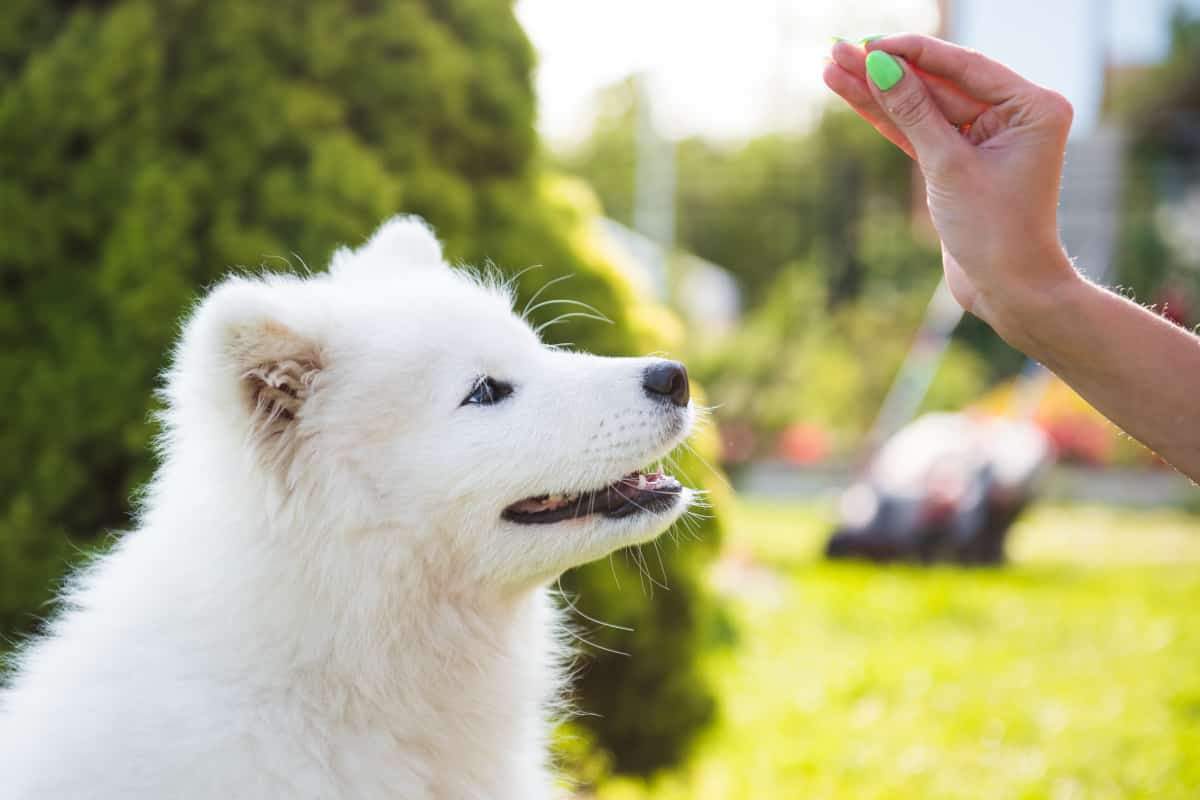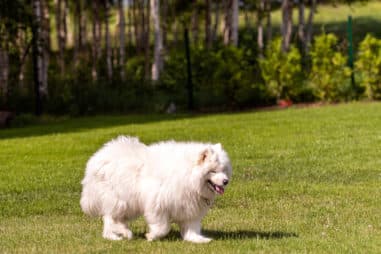It’s important to make sure they know what you expect of them. If they don’t, trouble will follow. They can also be hazy with some commands that you want them to learn.
Training and exercising a Samoyed puppy is easy because they learn fast. But there are a handful of important things to keep in mind. You must show them who’s the boss if they ever get unruly.
Their instincts will tell them that this is the case. Second of all, puppies that they are, they usually need a lot of physical exercise.
So, to train and exercise your Samoyed puppy you will need:
-
- Patience;
- A Lot of Time (but not too much since they get tired soon);
- Positive Reinforcement; and,
- The Right Attitude when training and exercising them (it must be fun).
How Do You Play With a Samoyed Puppy?
Playing with a Samoyed puppy is best done when you have time and space to spend energy. This canine breed comes with high levels of activity. They need plenty of mental and physical exercise to be happy and healthy.
Samoyeds do like fetch, but they’re also known for their very strong herding instincts. They enjoy jumping up and down while flashing their famous ‘Samoyed smile’.
This breed of dog is very people-oriented. If you intend to play with them, it should be an interactive game of chase or fetch with your Samoyed. Samoyeds are very sociable dogs, they enjoy the company of people, other dogs, and animals.
The best way to play with a Samoyed is to have at least two or more dogs. If you don’t have another dog at home, bring your pooch to a nearby local park. If there are other dogs in the neighborhood, allow them to interact with each other.
If your backyard is spacious enough, get out the ball and start throwing for your pup to chase after. Samoyeds love their exercise and this is a great way to tire them out.
These dogs are also known for being water dogs and they will likely enjoy playing in the pool if it isn’t too cold.
Make sure the water isn’t too deep and that you’re there to supervise them. Overexposure to cold can cause a Samoyed’s fur to fall out. It is a serious matter if it happens all the time or for a long time.
How Much Exercise Does a Samoyed Puppy Need?
The Samoyed breed originated in Siberia as sled dogs. Their strength and endurance are simply amazing. This suggests that these dogs don’t need to perform hardcore exercises.
But, to keep their energy levels under control, puppies need plenty of playtime. This will help them grow up into happy adults.
Here are some guidelines on how often Samoyeds should be exercised:
Puppyhood (up until 6 months old): Samoyed puppies need daily walks outside. If you can, these should be around 30 minutes long, at least five times a week.
Once they become Adolescents (6 months to 1 year old): A puppy will still need daily exercise. Although, this may drop down to three or four times per week (25 to 30 minutes per session).
Puppyhood (up until 6 months old) and Adolescence (6 months to 1 year old): These are the most energetic periods in a Samoyed’s life. As a Samoyed dog owner, you need to make sure they get enough playtime during these stages.
1 to 7 Years Old (Adult): This is when exercise requirements will begin to decrease. Take your Samoyed on a half-hour walk around the block once or twice a week. But this may vary depending on your dog’s current health. If you take them running or swimming, this will help maintain their fitness.
Adult: As they become adults, dogs will begin to slow down metabolically. But they still need exercise to help them stay healthy. It also reduces their risk of obesity.
Once a Samoyed is fully grown, you should take him on a daily walk that lasts around 10 to 20 minutes. You can then switch this up with some playtime or another activity that they enjoy.
How Long Should I Walk My Samoyed Puppy?
Samoyeds are one of the more high-energy breeds. These dogs need a lot of exercise to both keep them in shape and stay happy. In most cases, two short walks per day are usually enough.
The exact length of each walk can vary based on the dog’s age but is generally around twenty minutes per session. When your dog is a puppy, they require more walking because their muscles are growing. However, as they age, the number of walks lowers but the duration of each walk grows.
If your dog receives two 20-minute walks per day, increase that to 40 minutes at five years old.
On top of daily walks, it’s also recommended that you take your Samoyed to the dog park every once in a while. So your pet may receive even more exercise while meeting other Samoyed owners.
It’s also important that you train your dog not to pull on its leash when you are walking or jogging with it. This will allow both of you to have a much easier time getting the right amount of daily exercise.
Additionally, if your dog lives indoors throughout the day, you must take it outside. Do it at least one hour before bedtime. Doing so allows them to stretch their legs and tire themselves out before retiring for the night.
How Far Can a Samoyed Puppy Walk?
Samoyeds are one of the most active breeds in the canine universe. It shouldn’t be surprising that they can walk up to ten miles (16 kilometers) a day. Sometimes even more!
Unlike humans, who need to stop and rest their legs, Samoyed pups can walk all day. After all, if you’re going to be walking for miles, you’ll need to build up your endurance.
Bred as sled dogs, daily walks are essential for these dogs. It makes them healthy and fit enough to pull heavy sleds over long distances.
These days, they make excellent family pets and not as often as sled dogs. Although they still keep many of the traits that made them such good working dogs.
Like all dogs, the energy levels of Samoyeds will vary depending on the seasons.
In the summertime, Samoyeds can go for miles without getting weary. But come the winter months, their stamina drops. It’s not uncommon for a Samoyed puppy to only go a mile or two before being completely pooped.
Samoyed puppies have an amazing ability to walk up several miles per day. Hence, their daily walks are essential to keep them fit and healthy.
Why Is My Samoyed Puppy Breathing So Fast?
A heart condition can cause rapid breathing in some cases. Infections, tumors, and low oxygen levels all induce rapid breathing. Consult your veterinarian about it if your pet appears to be breathing fast. Whether from sleep, heat, or exercise.
Underneath their coat also, Samoyed puppies have very thin skin. Because of this, they become cold fast which will make them start breathing faster.
If you keep your dog out of the sun for too long, he may suffer hypothermia and have fast breathing.
The Samoyeds are most prone to congenital cardiovascular problems. They share the same tendencies with breeds like Maltese, Pomeranian, Miniature poodle, Chihuahua, and Yorkshire terriers. Any heart issue that causes shortness of breath puts your dog in danger.
Rapid breathing is a typical indication of severe cardiac disease in dogs. The reason might be anything. It could be from lung disease to brain tumors to myasthenia gravis or epilepsy.
How Do You Discipline a Samoyed Puppy
Puppies can be naughty, but with the right approach, they’ll know what proper behavior is all about.
Do’s and Don’ts When Disciplining a Samoyed Puppy
Do’s
- Make it clear what behavior is allowed and what isn’t.
- Keep a few small treats on hand to reward your pup for good behavior.
- Establish a positive tone of voice when disciplining your pup.
Don’ts
- Never hit your Samoyed, even if he does something nasty or destructive that can’t be ignored. You’ll only teach him that bad behavior is the way to get attention.
- Don’t reprimand or chastise your dog if he doesn’t understand your expectations. You can first set an example of proper conduct.
- Don’t let your pup get away with anything, even when she looks adorable and it’s just no fun to correct her. You have to be the boss or your pup might end up becoming a delinquent.
What to Do When Your Samoyed Puppy Disobeys
If your dog begins chewing on the remote control while you’re watching TV, take it away from him. Then try to offer him a toy instead. If he stops immediately, praise him and offer the toy again.
If your pup jumps on the couch, put him back onto all fours on the floor and then give him a treat when he’s calm.
If your Samoyed pup gets rough with you, stop playing immediately and ignore him for about 10 minutes. If he does it again, say “no” firmly, but don’t yell–your pup is still too young to understand yelling.
If you have a litter of puppies, it’s simple to ignore the bad behavior and reinforce the positive.
Are Samoyed Puppies Easy or Hard to Train?
Samoyeds are naturally one of the most docile in the canine universe. They have a strong desire to please their human family. They are bred to work in freezing cold climates and need lots of good reinforcement.
It does vary between individual Sammies though. Some are more easy-going and laid back, while others have a lot of spunk to be trained from the get-go.
Regardless of personality, all pups, especially Samoyeds, must be housebroken. It will help them develop healthy habits that will stick around for life. Whether that’s not chewing your TV remote or going to the corner when they need the toilet.
A Samoyed pup is very bright. Besides, they are also very eager to learn. So, it’s important to establish your role as their leader early on.
Start by encouraging good behavior with tasty treats that they’ll love. This way you’re letting them know when they’re doing something right. Then remove them if they act out – whether by nipping a hand or not going to the toilet outside.
You can start training a Samoyed puppy as soon as they’re ready, which is usually at around 12 weeks old.
They’re also very obedient and will respond well to verbal commands if you use them consistently. You must remain calm and assertive when teaching them things. That would include going to the toilet in a specific spot.
Be consistent in your training. Always reward them when they do the right thing. But you need to remove the rewards if they display unwanted behavior. Soon, you’ll have a Samoyed pup that’s ready to take on the world!
Do Samoyed Puppies Bark a Lot?
Do Samoyed puppies bark a lot? The answer is, they do! In fact, if you’re considering adopting a Samoyed puppy, it’s something you’ll need yourself to get prepared for.
Samoyeds are known as an “alpine” breed of dog – which means that they originate from the Siberian mountains, where it can get exceptionally cold. The Siberian mountains are very isolated and so the Samoyed’s only source of entertainment is barking – which they love doing.
So, in addition to being very playful and loving, Samoyed puppies are also vocal! They will bark when they see another animal or when they hear something strange.
They might even bark just because they’re bored!
How Do I Stop My Samoyed Puppy From Barking?
There are many reasons why your Samoyed might be barking. If you understand what they might be, then it becomes much easier to train them out of the habit.
Lonely – One of the reasons why a Samoyed puppy barks might be that they’re feeling rather lonely. This makes them bark to attract your attention.
As pack animals, they also enjoy being around other dogs. If you have an older dog then it’s worth trying to let them spend some time together while you supervise.
Annoyed – Samoyeds also know how to let you know when they’re annoyed! This is like barking out of loneliness. If your dog feels threatened, it may begin to bark in this manner.
Satisfying Their Curiosity – They’re not barking out of boredom or loneliness alone. They also bark out of curiosity.
If you have a fence around your house, this may worry your Samoyed. They will want to know whether it’s your neighbors working in their garden or another dog walking by.
Attention Seeking – Sometimes, all your Samoyed wants is attention. They’ll do anything that will get you to give it to them!
You may avoid this by rewarding your dog for positive behavior, not only for barking.
To Get You to Leave the House – Samoyeds are very clever dogs. They know that if they bark, there’s a high chance that you’ll realize how much of a nuisance they’ve been. Thus, you are likely to decide to leave the house!
This is why it’s important never to give your dog any attention when they bark, no matter how much you want them to stop.
The best thing that you can do for a Samoyed who barks a lot is to try to keep him entertained while you’re at home. You can do this by teaching them new tricks.
You can also give them lots of toys to play with, and also take them on daily walks.
By doing this you’re keeping their mind stimulated. This gives them no reason to bark because they will have the means to entertain themselves.
If your Samoyed is barking out of loneliness or boredom then you must give them some company!
You can do this by inviting another dog over to play with them. Or you can just throw a ball around the garden so they don’t feel so alone.
How Do You Stop a Samoyed Puppy From Biting?
Puppies, regardless of breed, are naturally playful and may bite as a part of their play. However, it is important to make sure that the bites do not hurt and cause injury.
If your young Samoyed puppy starts to nip at people or other pets, you should initially say “no” firmly and stop playing with him for a few minutes.
If he continues to nip you, stop playing with him entirely for the rest of the day. Doing so will make him realize that biting is not an acceptable way to interact with people.
If this does not work after a few tries, spray your pup in his mouth or on his nose with water from a plant mister while saying “no.” This will startle him and he will most likely stop playing with you.
If your pup still does not learn, then stop playing with him for a few days completely until he is calm again.
Not allowing the puppy to bite in the first place is much easier than trying to train him out of it later on when it is a habit. Before you play with your Samoyed puppy, just give one of his toys to him instead.
Puppies bite as part of their natural behavior. It is not always an attempt to dominate or an aggressive action. It might be a result of teething and exploring.
However, this does not mean that play biting is acceptable. Some bites may cause injury. Thus, it is important to make the puppy understand that this behavior is not allowed.
How to Potty Train a Samoyed Puppy
Potty training a Samoyed puppy is not an easy task. But the following instructions below should help make it a breeze. Besides, this also depends on their age and size. Smaller Samoyed puppies will be able to hold their bladder for less time than a bigger Samoyed puppy.
Taking your Samoyed outside to use the toilet is the first step in teaching him to pee and poop on command. Make sure they have their leash on as you take them out so that you can access them fast when needed.
Also, take the water bowl outside with you. Place it a few feet away from where your Samoyed is going to go. This will allow them to get their scent near the bathroom spot and know that this is where they should do their business.
Prepare a bag or two to pick up any waste dropped as you take them out to keep your house sanitary.
After your Samoyed has had some time to go potty, give them praise for doing so and then take them back inside the house.
Once you are in the door, remove their leash and praise them while you tell them that they did a great job using the bathroom outside.
Now that your Samoyed knows what you expect them to do, go back outside without the leash and again let your Samoyed relieve. As they are doing their business outside, pick up their dropped waste and place it in a bag to dispose of later.
After your Samoyed has finished in the bathroom (or you see that their bladder is about to burst), take your Samoyed back inside the house.
Upon entering, remove their leash. You want to tell them that they are doing a great job using the bathroom outside. This will help reinforce the positive behavior you want them to have.
Continue repeating this process throughout the day. This should assist your Samoyed to become used to knowing what to expect when they go potty.
That’s when you may start timing your Samoyed’s bladder holding time.
If your Samoyed does not follow this schedule and can hold it for more than three hours, increase their time outside.
Say, by another hour, until they are taking breaks every three hours. Once they get used to going outside on a certain schedule, then you can start increasing the amount of time between each trip outside.
How Do You Crate Train a Samoyed Puppy?
Crate training is simple but a crucial component of housebreaking your dog. Most dogs will not soil their resting place if allowed to avoid it.
Defining first what crate training is essential. Crate training involves teaching your dog that his/her crate is his/her private place, a place where all good things happen.
When you are at work or away from home, your dog will be comfortable in its crate knowing he is safe and his needs will be met (food, water, relief, etc.).
Your Samoyed puppy should feel the same way about its crate when it is in your house.
So, how do you crate-train your Samoyed puppy?
The answer is: do it sweet and slow but with lots of patience and consistency. For best results, your dog should not be forced to stay in the crate for extended periods of time during its initial training sessions.
- When you first introduce your puppy to his or her new crate, open the door, place some of their food inside and let them venture in on their own. Once they enter, give them lots of praise, encouragement, and a few tasty treats.
- When your dog is comfortable with the door open, begin closing the door (while they are eating) for short periods (5 to 10 minutes). You can do this by placing the food bowl on the opposite side of where you want them to sleep while standing in front of the closed door. If they get up, gently put them back in their crate.
- When your dog gets fine with the door closed for brief periods of time, place their food dish opposite the door. If they whine, talk to them and give them a treat through the crate wall (if possible).
- When your dog is comfortable with the door closed while they are inside, close it for brief amounts of time. You can do it without even food or water.
- When they whine/cry, talk to them in a calm, soothing way and give them a treat through the crate wall if possible.
- When your dog is comfortable with you closing the crate door for brief amounts of time, leave him/her inside it for shorter periods. You can progressively increase the time as they become used to it.
Eventually, you will have your puppy comfortably spending a few hours in his or her crate, but don’t expect your dog to be happy about it at first. Crate training is often considered one of the more difficult (but important) aspects of housebreaking your puppy.
Give them lots of praise and treats when they are inside their crate. If possible, try to play with them a little bit if they are not whining or crying. In time, your Samoyed puppy will be begging to go into its crate for comfort and privacy.







